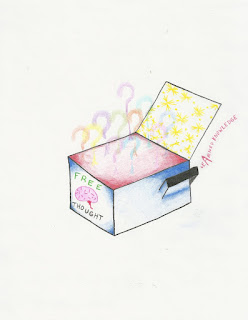

The painting on the left is titled Theater Box by Everett Shinn and was painted in 1906 using oil on canvas. The painting on the right is titled La vie paysanne (Peasant Life) by Marc Chagall and was painted in 1925 also using oil on canvas. These two paintings had an impact on me because they represent two completely different lifestyles, The first painting is painted in a first person perspective and depicts the viewer sitting in a theater box (which is one of the best seats in the house), watching a play; the feeling is that of a privileged person. The second painting depicts a peasant in a field with a horse observing people dancing in the background as well as children in a school, and passers by in a horse and buggy. The feeling this painting gives is that of a not so privileged person.


The painting on the left is titled La Voix des airs (The Voice of Space) by Rene Magritte and was painted in 1928 using oil on canvas. The painting on the right is titled Page Boy at Maxim's by Chaim Soutine and was painted in 1927 also using oil on canvas. I felt a connection with The Voice of Space because for a painting done in 1928, it has a futuristic Sci-fi feeling. I am interested in both space and sci-fi, so I thought this piece was really nice. I feel a connection to the Page Boy at Maxim's simply because I hate the piece, I actually look at it and I just hate it, its ugly. The last time I was at the Albright Knox museum was over 10 years ago and I saw and hated this painting then; sure enough its still there and when I turned the corner and saw this ugly bell boy staring at me I had to get a picture of the one piece of art in the museum that bothers me the most.


The painting on the top is titled Manao tupapau (Spirit of the Dead Watching) by Paul Gauguin painted in 1892 in oil on burlap mounted on canvas. The piece on the bottom is titled White Flag and was painted by Paul Fagerskiold in 2013 using oil paint, sand, and gravel on canvas, I would like to know more about the Spirit of the Dead Watching becausew the background information stated that the artist went to Tahiti to paint exotic things to fetch a higher price in paris. It got me wondering whether or not it worked because the info then side tracked into how this was a portrait of his 13 year old wife he met when he got to Tahiti (pretty controversial in present time). So, did he get the money? I would like to know more about the painting on the right and where the artist was coming from and what his message was. The painting depicts a style of flag the resembled the United States flag only its completely white which traditionally represents surrender. I was wondering, what should the United States surrender to? We are traditionally taught to never give up, its interesting to me.









